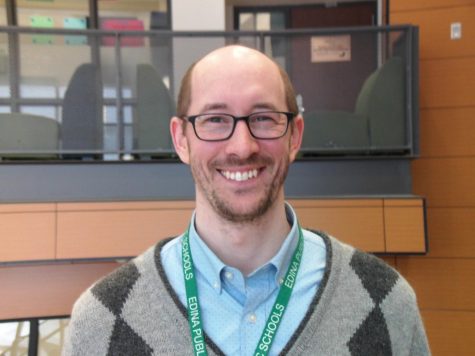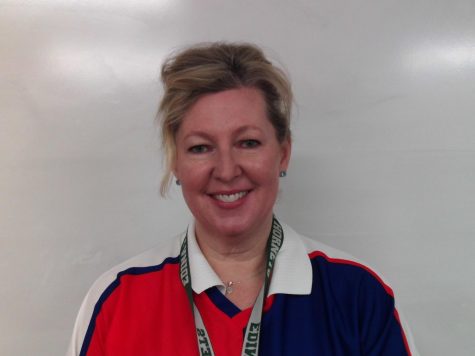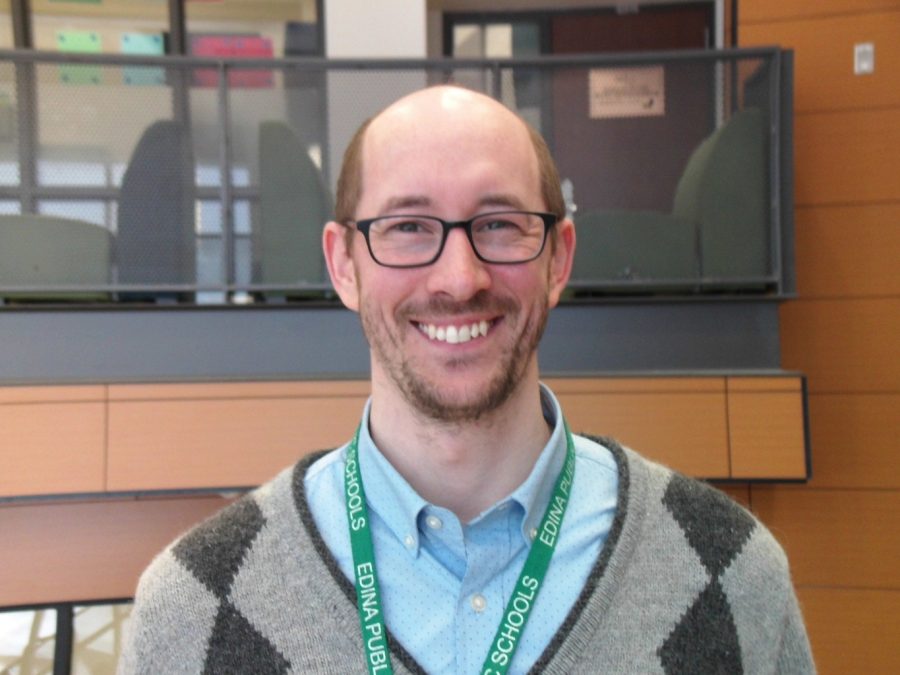Moving to EHS: behind the scenes with freshman teachers after the move
February 26, 2020
After the Edina High School incorporated freshmen into the student population, students, as well as teachers, had to adjust to a new environment. Read about Government teacher Claude Sigmund’s, Physics teacher Greg Pokorski’s, and English teacher Heidi Degener’s experiences about the switch.
Zephyrus: What is the biggest difference between teaching at the middle school and teaching at the highschool?
Claude Sigmund: A sense of community, I guess. At the middle school, every 9th grader knew who I was. I knew by name three-quarters of all the 9th graders. And here I only know the 9th graders I teach, and I could barely even tell you which students are ninth graders or tenth graders. Two, because it was so team-focused, it was like a family. I saw four other teachers every day for forty-five minutes. It was this big sense of community, and that’s a big difference. However, up here there’s a lot more sense of freedom, there’s a lot more choice. I get to teach eleventh grade, which I really like, teaching U.S. History, and I get those opportunities that I wouldn’t have had at the middle school. So those are sort of the bigger pieces. If you’re really an academic teacher, there’s a lot more opportunity to really push yourself at the high school because of the harder courses and the opportunity to teach other courses, and a much larger department to bounce ideas off of.
Z: How has teaching the subject of Government itself changed?
CS: At the highschool, because there’s many more people and more teachers and such, it’s much more what I call teaching by committee. Well, you have to make sure that you’re giving the same summative so you’re teaching the same things, the same content, and we would all be teaching the same content, but we would be teaching it differently, and we might be testing slightly differently, and we might be emphasizing different things. Now, we all have to meet together. Before it would be me and one other teacher that would be comparing, and there’s a lot of give and take, and now it’s a committee of let’s say six people that have to meet. And so sometimes that can be really difficult, because you feel like some of your teaching gets pushed aside at times, and other times you become really dominate and then somebody else might feel that way. So that part becomes difficult.
The other part though, is because there are older students in the building, you can make, I love making these displays on my windows that I have coming out. I’m making one for the primaries (it’s not done yet), but you know lots of people start stopping, and they are talking intelligently about it so I love walking out in the hall and having those conversations. At the middle school the only people that would see it would be my AP Government students or my Government students, and we would talk with them but nobody else would really pay attention.
Z: Since class periods are shorter in highschool, how has that changed how you format your lesson plans and testing spacing?
CS: A lot. I actually like the blended seven-period for three days a week and block two days a week. It’s a nice mixture. When I was teaching in block it was much more activity based because it was such a longer period of time, you could never lecture for 90 minutes, that would be painful. So, it would be sort of like we’re going to do fifteen minutes of lecture and a twenty minute activity right but on a shorter period of class that gets broken up so sometimes that’s hard to do, because if you give a lecture and then you do fifteen minutes activity and then you want to do a closing lecture to help, you have to wait till the next day, or you have to shorten the activity but then it doesn’t have the power at once. So those are kind of downfalls the shorter class period.
In history, either block or seven-period day, the shorter fifteen minute periods are fine, it’s really other subjects. Like in science, block is awesome, labs you know that kind of stuff, but if you are math or foreign language, shorter periods are way better because you want that short, constant everyday practice.
And I would think Orchestra is mixed, you know, to get sixty people to all get their instruments out and stands, it’s the first ten minutes that you just lost in class, and then you have to get ten minutes at the end so how much time do you really get to play as an orchestra? But you also want to play everyday, and that’s a way to guarantee that everybody is practicing everyday. I can see real pros and cons so I think this is kind of a nice blended .
Z: Do you ever notice a maturity level difference in your students at the highschool, and how would that impact how you address your students?
CS: Sure. I actually I found students [in the] middle school to be more mature than they are at the high school. They were the oldest group, and they took that to heart. Because it was sort of like high school with a safety net. And I knew all the students so well. There was a lot less shenanigans, a lot higher homework completion, that kind of thing. And then here, there’s a, it’s not just the jump from eighth to ninth grade in that big academic jump as a whole. But then you also have that loss of connection. So I found the ninth graders, to be as a whole more mature when they were at the middle school than they are here.
It’s sort of like freshman in college. If they don’t have, you know, a lot of them don’t do very well their freshman year in college because suddenly they have all this freedom that they never had before and, you know, right, sort of that same concept, now I’m not saying this is true of all freshmen by any stretch of the imagination, there are a lot of people that jump into it and I’m like, yeah, you know, but, but that’s just the freshmen, you know, but then I have the opportunity to work with tenth eleventh or twelfth graders they have that different.

Zephyrus: What is the biggest difference between teaching at the middle school and teaching at the highschool?
Greg Pokorski: Well, something that’s potentially in the works for next year is the idea of teaming ninth grade teachers, so that a student would have the same Physics teacher, government teacher, and language arts teacher, and that would be true of all students that had those teachers, and that was true in the middle school, and that was a really big benefit in terms of being able to find students that were struggling and then implement large scale support for them to be more successful. So that’s something that I’m looking forward to potentially participating in again next year. But I think the biggest difference is the switch from having a few relationships that I would develop with younger students over time and then eventually, having them as my students in ninth grade to having a lot of students that I’ve never met before, in ninth grade and then being able to continue to see them and interact with them and talk with them as they grow and continue to the high school, so I really like having that opportunity to continue to talk with former students and see what they’re doing and how everything’s going.
Z: How has teaching the subject of Physics itself changed?
GP: The Physics department is somewhat unique in the school because every Physics room executes the same lesson plan from the same presentation, every day. So, we have all of the same formative assessments, summative assessments, resources available to all the students, and we do that by design. The idea is that if a student has a particular teacher but then needs to come in to ask a question about an assignment that teacher is not there, they can ask any Physics teacher, and we’re all in the same spot we can all answer that question and the resources to the students. So that being exactly the same, all around the Physics area is different from what it used to be, because we have lots of materials we can pull that off, whereas at the middle school we maybe had to stagger a lesson by a day or two to make sure that everybody had a chance to use all of the materials.
Z: Since class periods are shorter in highschool, how has that changed how you format your lesson plans and testing spacing?
GP: We have to pay more attention to when things happen. When we used to have all block days, all the time, it was easy to put a lab on any particular day. We never had to worry about it fitting into class period, whereas now we either have to purposefully break that lab up into a couple of sections so that we can do one part and have a natural stopping point at the end of one period, or make sure that it falls on a block day so that we can do all of it in the same amount of time. For testing, we have generally tried to stay away from block days for testing so that we have one part of a summative on one seven period day and then another part on another seven period day, rather than trying to put both together in the same block period.
Z: Do you ever notice a maturity level difference in your students at the highschool, and how would that impact how you address your students?
GP: I don’t know if maturity is necessarily the right way to describe the change that we’ve all noticed. Because it seems like our students are now more aware than they were in middle school of all of the resources that are available to them how they can address any issues related to not understanding something, or needing extra help, or having a question answered, but many of them are also content to not address those misunderstandings or questions or things like that. And so I don’t know if that relates to maturity, it might, but that’s the big difference. The kids know how they could address issues, but more often than in middle school, they are choosing not to address them.

Zephyrus: What is the biggest difference between teaching at the middle school and teaching at the highschool?
Heidi Degener: I think that schedules and collaboration are different. So in the middle school we had the A-day B-day schedules and at high school of course we have seven-period day and odd and even [days]. We also in middle school had advisory almost every day or every day. So, that schedule piece is different. And in terms of collaboration for teachers in the middle school we work with teachers of different disciplines. So we have interdisciplinary work and in the high school we work more with our own department. So that’s a big difference for a middle school teacher coming to the high school. We are also the ninth grade teachers taught, the oldest in the, in the school. And now we teach the youngest. That’s fun to see our former students walk around. And it’s a bigger school, so more people and more space versus a smaller school space.
Z: How has teaching the subject of English itself changed?
HD: Well, in the middle school our teaching teams were relatively small two to three people teaching the same course. So, currently there’s seven teachers teaching Pre-AP English 9. So with that comes a wealth of experience and rich background and perspective, but it is also more challenging for us to make sure that we are all always on the same page with regard to schedules and our units. So there’s a bit more organization when you have a larger team, but it also brings the benefits of, you know, having all of those different perspectives.
Z: Since class periods are shorter in high school, how has that changed how you format your lesson plans and testing spacing?
HD: One of the pieces we had to change in ninth grade English was the testing. Because with a longer class period, you could do multiple activities within one day, but it seemed that the tests were dominating the shorter class periods in ninth grade English. So we kept the breath of the test but we trimmed back the questions. Yeah, because otherwise we couldn’t you know with seven minutes remaining in the class there’s not a whole lot you can do with that so that allows us to do more than one thing on a test day.
Z: Do you ever notice a maturity level difference in your students at the highschool, and how would that impact how you address your students?
HD: I think that when students are the oldest in the building, there’s a sense of what is kind of an earned place that they have sought after. They are deserving of being kind of that oldest group, and they enjoy that position. And I think the ninth graders, once they’re at the high school, they’re a bit more wary because it’s all just brand new, and I wouldn’t say it’s a difference in maturity, I just think it’s a difference in their, how they perceive their high school experience or their ninth grade experience. It’s not the capstone of middle school, it’s now the beginning of high school.



